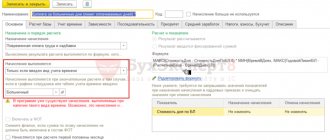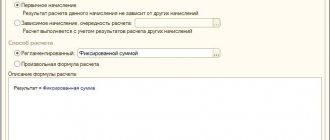Material assistance is paid to employees as a special monetary reward. The procedure for its calculation, accrual and taxation raises many questions, including the question of how the availability of financial assistance affects the calculation of vacation pay and average earnings.
The issuance of financial assistance and the list of acceptable grounds are determined by local regulations of the enterprise. An organization can formalize the procedure for issuing it as a separate document or include it in the main regulations for payments and compensation.
Is financial assistance included?
When paying annual leave, the accounting department employee sums up the employee's annual earnings and divides them by days worked. The result obtained is multiplied by the number of days. See the step-by-step procedure for calculating vacation pay here.
Current legislation, when calculating average earnings to determine the amount of payment for annual leave, regulates taking into account all the employee’s income paid to him within the framework of the remuneration system.
Step-by-step algorithm for calculating average earnings for vacation pay.
Earnings include: salary, allowances for special working conditions, overtime, bonuses, bonuses.
Compensation payments are not included in the calculation of average earnings.
Financial assistance is not a payment accrued in connection with the performance of official duties, but is financial support for an employee in difficult life situations.
For example, an employer can transfer money to a subordinate in connection with the birth of a child, marriage, death of a relative, or illness. The decision to pay funds is made by the head of the enterprise on the basis of local acts or on his own initiative.
Based on this, we can conclude that financial assistance is not included in the calculation of average earnings for vacation pay.
We recommend reading:
- how do travel allowances affect the calculation of vacation pay;
- how sick leave is taken into account when calculating vacation;
- Are one-time bonuses included?
How is it taken into account for civil servants?
The situation of calculating vacations is complicated by special legislation for civil servants. Decree of the Government of the Russian Federation No. 562 of September 6, 2007 (clause 6) indicates that financial assistance is included in the employee’s total earnings when calculating vacation pay for employees of federal departments in the amount of 1/12 of each accrued payment for 1 year before the start of the vacation.
A similar requirement applies to all government employees, with the exception of those whose remuneration depends on performance results.
These payments must meet the following criteria: lack of incentive nature, regularity of payments, dependence on the results of work activity.
In practice, legislative acts indicate that regional and municipal employees do not have a similar right.
FAQ
The process of calculating vacation pay quite often raises questions among employees. Indeed, the law says little about making calculations.
In fact, all actions are carried out by the accounting department and it can be very difficult to determine the correctness of the calculations.
In addition, in practice, different situations arise that should also be taken into account when making calculations. For example, how is the average salary for a part-time worker calculated, will income for an incompletely worked month be taken into account, and are all bonuses excluded from the income base?
Partial month worked
We have already mentioned that when calculating average earnings, only fully worked months are taken into account. What to do if an employee was sick or on maternity leave during the billing period? Or in his case there were other periods that should be excluded.
If such a situation arises, then it is necessary to take into account not the entire month, but only those days that the employee performed his labor function, then in order to calculate the days included in the total period, the following calculations must be performed:
29.3/number of days in a month*days that the employee performed his job function.
Let's demonstrate with an example. Ivanov A.P. goes on vacation. In September he took sick leave for 14 days. Accordingly, he actually worked for 16 days. Now let’s calculate the number of days that will be included in the billing period: 29.3/30*16=15.63
Do bonuses count?
Cash rewards are part of the remuneration system, so they are included in the income part. The timing of the accrual of the incentive does not matter.
Payments that are made per day, month or year are taken into account equally if they were issued during the billing period.
But these rules apply only to bonuses that are defined by internal documents and are not one-time in nature.
This is interesting: Contract for supply of drinking water
When should vacation pay be transferred according to the law? Read here.
Do I need to pay insurance premiums from vacation pay? Details in this article.
Part-time job
The part-time worker has the right to leave. Weekends at additional work are provided in parallel with the rest period at the main place.
Vacation pay is calculated according to the same rules.
Example of vacation pay calculation
Below are two examples of calculating payment for vacation, when financial assistance was paid to a civil servant and a non-state employee.
For employees of non-government structures
Initial data:
During the billing period, the employee received a salary in the amount of 350,000 rubles.
He applied for leave in July for 28 days.
In June he fell ill and was given sick leave for 7 days. Number of days worked this month: 30-7=23 days. Total number of days in a partially worked month: 29.3/30*23=22.46.
In May, in connection with the birth of a child, he was given financial assistance in the amount of 8,000 rubles.
Vacation pay calculation:
In this example, financial assistance assigned and paid in May is not included in the calculation of average daily earnings.
Average earnings = 350,000 / (11 * 29.3 + 22.46) = 1015.20 rubles.
Vacation pay = 28 * 1015.2 = 28425.6 rubles.
For civil servants
Initial data:
The vacation was issued from October 1, 2019 for 14 days. Monthly salary (in rubles):
- 7900 - salary;
- 1690 - additional payment for rank;
- 790 - for length of service;
- 9480 - for special conditions;
- 700 - 1/12 of financial assistance for the previous year;
- 800 - 1/12 of all bonuses for the year before the vacation.
Calculation:
The above types of surcharges are fully included in the calculation.
Amount of vacation pay = (7900+1690+790+9480+700+800) / 29.3 * 14 = 10206.14 rubles.
From this amount, personal income tax should be withheld at 13% and insurance premiums payable at a general rate of 30%.
Features of accrual
Vacation pay is payments that are made while an employee is on vacation. During this time, the employee does not receive wages.
The funds are provided to him at a time - 3 days before the vacation.
Vacation pay is calculated based on average earnings. To obtain this indicator, it is necessary to identify the billing period and summarize the income received during this period.
The legislator defines the concept of average earnings in the Labor Code of the Russian Federation. It is necessary to adhere to the rules established by law for its calculation.
What payments are taken into account?
When calculating average earnings, the employee's payments for the pay period are taken into account. You need to know that not all profits will be considered when making calculations.
Thus, the following incomes are not taken into account when calculating average earnings in 2020:
- temporary disability benefits;
- benefits that are not subject to personal income tax;
- business trips;
- payments that are compensatory in nature (for food, travel, etc.).
Certain types of bonuses are not taken into account in the calculations. Namely, those that are not provided for by the accepted employee remuneration system.
Average earnings
Average earnings are calculated using the formula: income received in the billing period/12/29.3, where:
- 12 – number of months of the billing period (may be less than 12);
- 29.3 – average number of days in a month.
When calculating average earnings, it is necessary to obtain data on the employee’s income for the billing period.
Such payments include the following:
- salary size;
- profit from piecework;
- non-monetary remuneration;
- royalties;
- additional payment for performing work functions overtime;
- bonuses and additional payments that are established by the remuneration system.
The billing period is determined in months that are fully worked out.
Days are excluded from this period if the employee did not work due to the following reasons:
- absence from work due to illness or injury, which is confirmed by a certificate of temporary incapacity for work;
- maternity leave;
- periods of downtime;
- leave without pay.
Questions from our readers
Ask your question in the comments below and get a free answer! |
How to apply
Registration occurs in different ways, depending on the specific situation.
Budgetary institutions
In order for a civil servant to receive this money, he writes a statement:
- to receive leave;
- to pay financial assistance to him.
It is required no more than once a year. The boss, based on this document and relevant regulations, issues an order to grant leave and pay this money. When issuing vacation pay, the employee simultaneously receives the amount in question.
For commercial organizations
Other categories of employees carry out registration depending on whether the enterprise has adopted internal documents that stipulate the obligation to provide this money.
Typically, these things are indicated in the following documents:
- collective agreement;
- employment contract with this employee;
- local regulatory act of a given enterprise or organization.
If such a payment is regulated by one of the specified documents, then the registration mechanism occurs as indicated in them.
The usual procedure for receiving money in the absence of the mentioned papers is that the employee writes a statement with a corresponding request addressed to the head of the enterprise, and the latter, if he deems it necessary, issues an order, which for the accounting department is the basis for making an accrual.
How financial support is paid
To get checkmate. assistance, the employee needs to write an application and attach documents confirming the need for these funds. This type of assistance has the following characteristics:
- calculated individually;
- not paid systematically;
- is not an encouragement;
- does not reimburse costs;
- is accrued regardless of salary, career growth or the company’s field of activity.
The application is submitted to the manager. If he decides in favor of transferring financial assistance, a separate order is issued. It states the employee’s full name, reason and a link to a document confirming it, the specific amount, and the payment period. The source from which funds will be allocated is also taken into account - from profit for a period of time or from wages.
What are social benefits?
Social benefits are allocated for travel, food, training and other needs. One of their varieties is financial assistance. It is not related to the employee’s performance of his immediate duties, is not paid systematically and is accrued on an individual basis. Purpose mat. assistance – to help an employee in difficult financial circumstances.
Payments are provided for the following cases:
- the approach of an event that requires large expenses - for example, a wedding or funeral;
- need for treatment;
- unexpected loss of funds.
Mat. assistance is provided to working employees, members of their families, and retirees who worked at this enterprise. Information on the payment procedure is included in the text of the employment contract. It is also possible for the organization to adopt a separate provision regulating the accrual of financial assistance.
Important! Additional payments to vacation pay, which are awarded as incentives, cannot be equated to financial assistance. They are related to the employee’s labor achievements.







